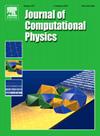A semi-Lagrangian adaptive-rank (SLAR) method for linear advection and nonlinear Vlasov-Poisson system
IF 3.8
2区 物理与天体物理
Q2 COMPUTER SCIENCE, INTERDISCIPLINARY APPLICATIONS
引用次数: 0
Abstract
High-order semi-Lagrangian methods for kinetic equations have been under rapid development in the past few decades. In this work, we propose a semi-Lagrangian adaptive rank (SLAR) integrator in the finite difference framework for linear advection and nonlinear Vlasov-Poisson systems without dimensional splitting. The proposed method leverages the semi-Lagrangian approach to allow for significantly larger time steps while also exploiting the low-rank structure of the solution. This is achieved through cross approximation of matrices, also referred to as CUR or pseudo-skeleton approximation, where representative columns and rows are selected using specific strategies. To maintain numerical stability and ensure local mass conservation, we apply singular value truncation and a mass-conservative projection following the cross approximation of the updated solution. The computational complexity of our method scales linearly with the mesh size N per dimension, compared to the complexity of traditional full-rank methods per time step. The algorithm is extended to handle nonlinear Vlasov-Poisson systems using a Runge-Kutta exponential integrator. Moreover, we evolve the macroscopic conservation laws for charge densities implicitly, enabling the use of large time steps that align with the semi-Lagrangian solver. We also perform a mass-conservative correction to ensure that the adaptive rank solution preserves macroscopic charge density conservation. To validate the efficiency and effectiveness of our method, we conduct a series of benchmark tests on both linear advection and nonlinear Vlasov-Poisson systems. The proposed algorithm will have the potential in overcoming the curse of dimensionality for beyond 2D high dimensional problems, which is the subject of our future work.
求助全文
约1分钟内获得全文
求助全文
来源期刊

Journal of Computational Physics
物理-计算机:跨学科应用
CiteScore
7.60
自引率
14.60%
发文量
763
审稿时长
5.8 months
期刊介绍:
Journal of Computational Physics thoroughly treats the computational aspects of physical problems, presenting techniques for the numerical solution of mathematical equations arising in all areas of physics. The journal seeks to emphasize methods that cross disciplinary boundaries.
The Journal of Computational Physics also publishes short notes of 4 pages or less (including figures, tables, and references but excluding title pages). Letters to the Editor commenting on articles already published in this Journal will also be considered. Neither notes nor letters should have an abstract.
 求助内容:
求助内容: 应助结果提醒方式:
应助结果提醒方式:


